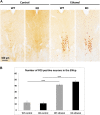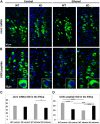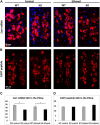Functionally active TRPA1 ion channel is downregulated in peptidergic neurons of the Edinger-Westphal nucleus upon acute alcohol exposure
- PMID: 36704197
- PMCID: PMC9872022
- DOI: 10.3389/fcell.2022.1046559
Functionally active TRPA1 ion channel is downregulated in peptidergic neurons of the Edinger-Westphal nucleus upon acute alcohol exposure
Abstract
Introduction: The centrally projecting Edinger-Westphal nucleus (EWcp) contributes to the control of alcohol consumption by its urocortin 1 (UCN1) and cocaine- and amphetamine-regulated transcript (CART) co-expressing peptidergic neurons. Our group recently showed that the urocortinergic centrally projecting EWcp is the primary seat of central nervous system transient receptor potential ankyrin 1 (TRPA1) cation channel mRNA expression. Here, we hypothesized that alcohol and its metabolites, that pass through the blood-brain barrier, may influence the function of urocortinergic cells in centrally projecting EWcp by activating TRPA1 ion channels. We aimed to examine the functional activity of TRPA1 in centrally projecting EWcp and its possible role in a mouse model of acute alcohol exposure. Methods: Electrophysiological measurements were performed on acute brain slices of C57BL/6J male mice containing the centrally projecting EWcp to prove the functional activity of TRPA1 using a selective, potent, covalent agonist JT010. Male TRPA1 knockout (KO) and wildtype (WT) mice were compared with each other in the morphological studies upon acute alcohol treatment. In both genotypes, half of the animals was treated intraperitoneally with 1 g/kg 6% ethanol vs. physiological saline-injected controls. Transcardial perfusion was performed 2 h after the treatment. In the centrally projecting EWcp area, FOS immunohistochemistry was performed to assess neuronal activation. TRPA1, CART, and urocortin 1 mRNA expression as well as urocortin 1 and CART peptide content was semi-quantified by RNAscope in situ hybridization combined with immunofluorescence. Results: JT010 activated TRPA1 channels of the urocortinergic cells in acute brain slices. Alcohol treatment resulted in a significant FOS activation in both genotypes. Alcohol decreased the Trpa1 mRNA expression in WT mice. The assessment of urocortin 1 peptide immunoreactivity revealed lower basal urocortin 1 in KO mice compared to WTs. The urocortin 1 peptide content was affected genotype-dependently by alcohol: the peptide content decreased in WTs while it increased in KO mice. Alcohol exposure influenced neither CART and urocortin 1 mRNA expression nor the centrally projecting EWcp/CART peptide content. Conclusion: We proved the presence of functional TRPA1 receptors on urocortin 1 neurons of the centrally projecting EWcp. Decreased Trpa1 mRNA expression upon acute alcohol treatment, associated with reduced neuronal urocortin 1 peptide content suggesting that this cation channel may contribute to the regulation of the urocortin 1 release.
Keywords: JT010; alcohol; centrally projecting Edinger-Westphal nucleus; cocaine-and amphetamine-regulated transcript; transient receptor potential ankyrin 1; urocortin 1.
Copyright © 2023 Al-Omari, Kecskés, Gaszner, Biró-Sütő, Fazekas, Berta, Kuzma, Pintér and Kormos.
Conflict of interest statement
The authors declare that the research was conducted in the absence of any commercial or financial relationships that could be construed as a potential conflict of interest.
Figures






References
LinkOut - more resources
Full Text Sources
Research Materials

